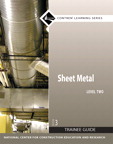Safety is a skill. And like any skill, it takes practice to perfect. As a company, this should be your first priority. “When employees feel like their employer is willing to take care of them and do whatever it takes to make them safer, they have a better sense of ownership,” explains Donovan Seeber, vice president of corporate safety at the West Coast-based ACCO Engineered Systems. When employees feel safe, they are more productive, he explains. This is the key to developing a culture around safety. “And that’s something that everyone has to understand,” adds Ralph Natale, a 30-year industry veteran who has been the safety director of the Pittsburgh-based McKamish Inc. for 20 years. “Developing a culture is just that, developing a culture.”
Each year, the Occupational Safety and Health Administration issues millions of dollars in safety citations after safety inspections and workplace accidents where shops are found liable. Not to mention the amount of indirect loss shops suffer from facility damage, replacement and workers compensation costs.
When Seeber and Natale gave a talk on strengthening shop safety program this year at the annual SMACNA convention, they had some unexpected advice: Throw the rulebook out and start a living, breathing program.
“So it’s not putting out a safety book and letting that collect dust, it’s a living thing you have to keep tending to it and fostering it,” Natale explains. Where to begin?
Here, they give part two of their talk and walk us through their top five tips to turning a safety program into a safety culture.
#1. Throw out the rulebook
Rulebooks will rarely rescue employees from accidents. Developing a culture around safety is about turning those pages into a regularly practiced program.

Ralph Natale
“When I got to McKamish, they really didn’t have anything,” Natale says, save for Keller’s “OSHA Safety Training Book.” “So I started from scratch.”
When Natale arrived to McKamish, they had an excess of 30 reportable injuries. “It wasn’t nice,” he says. Since then he has lowered the company lost time incident rate (LTIR) from 4.16 to 0.0, and a recordable incident rate (RIR) from 8.78 to 0.83.
“I had to look at how they were actually operating,” says Natale. “It’s not something that’s easily developed and administered in a two month period or a two year period. It takes several years in order for you to get everybody into that mindset that safety is a culture. It is a belief system.”
#2. Culture comes from the CEO
Commitment from CEOs, management, first line supervisors to safety in the form of observable reviews (management site/ project safety observations), quarterly safety leadership team (SLT) meetings and other key upper management meetings makes developing a culture around safety real and successful, says Seeber.
“Safety is not only important to our success, but it is a value that we hold in the highest regard throughout our organization, he says. “Safety performance does not happen by luck; you must have a strategy to accomplish your goals.” The CEO and other management departments set the tone for it all.
#3. Bid the job and the job site
Most contractors will agree that no two construction sites are the same. With that in mind, shops should not only be thinking about how to complete a job but also how to complete a job safely.

Donovan Seeber
“That’s the part of the development of a culture, says Natale. “Your core people have to understand that they are taking that culture with them wherever they go. And at whatever job site they are at. We are not just looking at a bunch of rules and expect you to follow the rules, and everything will be OK. It’s looking at what you have to do within the rules and then developing more techniques in order to preserve the safety of the job site.”
At ACCO, Seeber uses site specific safety plans, daily site safety meetings and job specific safe execution plans to make sure everyone is on the same page when it comes to safety performance.
“Site Specific Safety Plans includes plans designed specifically for the site project such as analysis of client safety procedures vs. company to identify policies that may differ from site to site or companies and used as an education tool for site team,” he says.
#4. Test your tools
The best way to avoid machinery and tool-related accidents is to know they work and are functional. “Now you’re getting into the theoretical part of it because the person operating the machine should be inspecting the machine. So that’s one of the key concepts that we have. You don’t just pick up a tool and assume it’s operable,” says Natale. “We do a monthly tool inspection, a process we started years ago, where we tape our tools according to the job site. The bottom line is that you know they are safe when they go out.”

#5. Get everyone on board
From the front desk to the foreman, developing a culture around safety means getting everyone involved with the program. “Again as you develop this culture, the severity of the injuries goes down, and this concept that all injuries can be prevented goes up,” explains Natale. “When you have people who are happy and they like where they are, like where they work, they work better; they work safer. They aren’t distracted. We want to get your entire team with that attitude.”
Seeber adds, “Culture by definition is just what’s normal. So you want your safety culture to continuously evolve and get better over time. It’s something that you’re never done with. You always have to try and get better.”
Top 10 citations in 2017 from the Occupational Safety and Health Administration (OSHA)
Fall protection, construction
(29 CFR 1926.501)
In 2016, the Bureau of Labor Statistics (BLS) reported that 991 construction workers died on the job, with 38.7 percent of those fatalities resulting from falls. Employers must set up the work place to prevent employees from falling off of overhead platforms, elevated work stations or into holes in floor and walls. OSHA requires that fall protection be provided at elevations of four feet in general industry workplaces, five feet in shipyards, six feet in the construction industry and eight feet in long shoring operations. In addition, OSHA requires that fall protection be provided when working over dangerous equipment and machinery, regardless of the fall distance.
Fall Protection–Training Requirements
(29 CFR 1926.503)
The employer shall provide a training program for each employee who might be exposed to fall hazards. The program shall enable each employee to recognize the hazards of falling and shall train each employee in the procedures to be followed in order to minimize these hazards.
Hazard communication standard,general industry
(29 CFR 1910.1200)
Chemical manufacturers and importers are required to evaluate the hazards of the chemicals they produce or import and prepare labels and safety data sheets to convey the hazard information to their downstream customers; all employers with hazardous chemicals in their workplaces must have labels and safety data sheets for their exposed workers and train them to handle the chemicals appropriately.
Scaffolding, general requirements, construction
(29 CFR 1926.451)
In a Bureau of Labor and Statistics (BLS) study, 72 percent of workers injured in scaffold accidents attributed the accident either to the planking or support giving way, or to the employee slipping or being struck by a falling object. All of these can be controlled by compliance with OSHA standards.
Respiratory protection, general industry
(29 CFR 1910.134)
An estimated 5 million workers are required to wear respirators in 1.3 million workplaces throughout the United States. Selecting the right respirator requires an assessment of all the workplace operations, processes or environments that may create a respiratory hazard. The identity of the hazard and its airborne concentrations need to be determined before choosing a respirator. This assessment should be done by experienced safety personnel or by an industrial hygienist.
Control of hazardous energy (lockout/tagout), general industry
(29 CFR 1910.147)
Energy sources including electrical, mechanical, hydraulic, pneumatic, chemical, thermal, or other sources in machines and equipment can be hazardous to workers. During the servicing and maintenance of machines and equipment, the unexpected startup or release of stored energy can result in serious injury or death to workers. Failure to control hazardous energy accounts for nearly 10 percent of the serious accidents in many industries. Proper lockout/tagout (LOTO) practices and procedures safeguard workers from hazardous energy releases.
Ladders, construction
(29 CFR 1926.1053)
Each self-supporting portable ladder: At least four times the maximum intended load, except that each extra-heavy-duty type 1A metal or plastic ladder shall sustain at least 3.3 times the maximum intended load. The ability of a ladder to sustain the loads indicated in this paragraph shall be determined by applying or transmitting the requisite load to the ladder in a downward vertical direction. Ladders built and tested in conformance with the applicable provisions of appendix A of this subpart will be deemed to meet this requirement.
Powered industrial trucks, general industry
(29 CFR 1910.178)
Determining the best way to protect workers from injury largely depends on the type of truck operated and the worksite where it is being used. Employers must ensure that each powered industrial truck operator is competent to operate a powered industrial truck safely, as demonstrated by the successful completion of the training and evaluation.
Machinery and Machine Guarding, general requirements
(29 CFR 1910.212)
Employee exposure to unguarded or inadequately guarded machines is prevalent in many workplaces. Consequently, workers who operate and maintain machinery suffer approximately 18,000 amputations, lacerations, crushing injuries, abrasions, and over 800 deaths per year. Amputation is one of the most severe and crippling types of injuries in the occupational workplace, and often results in permanent disability.
Electrical, wiring methods, components and equipment, general industry
(29 CFR 1910.305)
Working with electricity can be dangerous. Engineers, electricians, and other professionals work with electricity directly, including working on overhead lines, cable harnesses, and circuit assemblies. Others, such as office workers and sales people, work with electricity indirectly and may also be exposed to electrical hazards. OSHA’s electrical standards are designed to protect employees exposed to dangers such as electric shock, electrocution, fires, and explosions.








